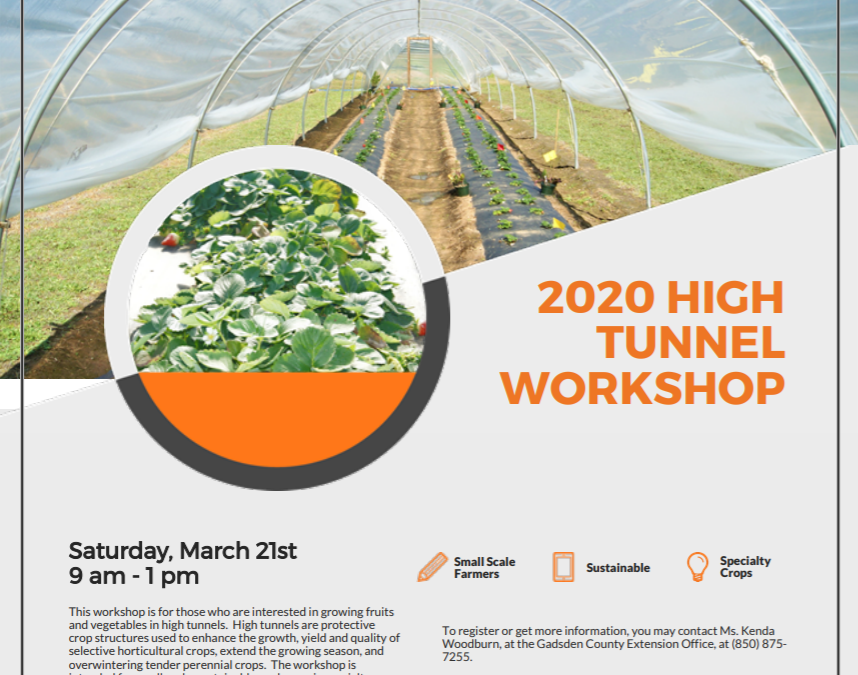
by KR Woodburn | Jan 31, 2020



2020 High Tunnel Workshop
March 21, 2020
Agenda
- 9 A.M. Welcome
Mrs. Vonda Richardson, FAMU Extension, Director
- 9:10 High Tunnels: Site and Crop Selection Considerations for High Tunnels
Dr. Alex Bolques, FAMU Extension/REC – Utilizing Floating Row Covers to Exclude Insect Pests and Increase
Winter Protection in High Tunnels – Ms. Kenda Woodburn, FAMU Extension Agent, Gadsden County
- 9:30 Integrated Management Practices for High Tunnel Organic Vegetable
Production -Dr. Xin Zhao, UF Horticultural Sciences
Hot Pepper, Strawberry, and Leafy Green Production in Protective
Structures -Dr. Gilbert Queeley and Alex Bolques, FAMU Extension
- 10:20 Break
- 10:30 Monitoring and Management of Pest and Beneficial Insects in the High Tunnel Production Systems – Dr. Muhammad Haseeb, FAMU Center for Biological Control
- Cultural Management of Insect Pests: Plant-mediated Push-Pull Technology – Dr. Susie Legaspi, ARS Research Entomologist
- 11:20 Field Demonstration: Protected Ag
- Short walk to high tunnel areas
– Leafy greens production using organic methods
– Sustainable strawberry production using organic methods
– Low cost high tunnel structural improvements
– Strawberry season extension
– Selective vegetable hydroponic production systems
- 12:30 Lunch and Learn:
High Tunnel Cost Sharing Opportunities
Mrs. Karyn Ruiz-Toro, NRCS District Conservationist
Resources & Supplies for High Tunnel Growers
Ms. Kenda Woodburn, FAMU Extension
1 P.M. Adjourn

by Beth Bolles | Aug 28, 2019
More and more homeowners are incorporating edible plants into their home landscape in order to enjoy the fresh taste of fruits and vegetables. Another trend to consider this coming cool season is to start a few common flowers that can serve as flavor enhancements for many of your dishes.
There are numerous plants that we commonly grow that have edible flowers but before striking out on your first taste test, be sure to research first. Always remember the common saying that every flower is edible once. Find a reputable reference guide from a friendly neighborhood Extension office for a list of common edible flowers, then be ready to start from seeds. It is best not to purchase transplants from an ornamental nursery unless you are sure of all the treatments for that plants. Nurseries are often selling these for beauty alone, not with intention that they will be eaten.
Here are a few edible flowers to try:
Pot marigold or Calendula is a wonderful cool season flower on its own. Brightly colored orange or yellow flowers improve the drab colors of our cool season and plants are sturdy annuals for borders, mass plantings, or in containers. Petals have a peppery flavor and add spice to salads and sandwiches. You may also add flowers to soups, fishes and butters for added coloring. Calendula petals can be a saffron substitute.
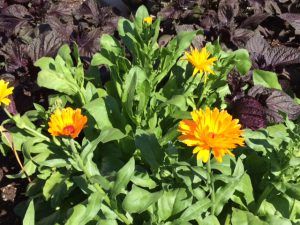
Calenduala is easily started from seeds and will reseed in your garden once established. Photo by Beth Bolles, UF IFAS Extension Escambia County.
The well known dianthus is a great transition plant as our days cool and warm up again the spring. Use as front of the border plantings or in containers as a filler. When harvesting petals of dianthus, you will want to remove the white petal base which is a little bitter. The flavor is a little more delicate than cloves so you can add petals to punches, desserts, and fruit salads.
If you like a little more spice, try nasturtiums. We often plant these after the last frost and they grow until we get too hot. Since our fall weather is so unpredictable, you may be able to start some seeds for a fall planting and have flowers before our first cold spell. Either way, nasturtium flowers are often sliced for salads and sandwiches as a mustard or pepper substitute. You can also mince flowers to add to a butter. If you let some flowers go to seed, collect the unripe seeds to make a caper substitute vinegar.
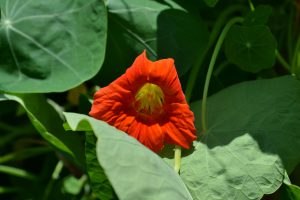
Grow nasturiums during our transition times of spring and fall. Photo by Beth Bolles, UF IFAS Extension Escambia County.
If you are going to use edible flowers from your garden remember to keep all non food labeled pesticides away from plants. Harvest flowers at their peak after the dew dries. Separate petals from other flower parts and if you have allergies be sure to remove any pollen. Place flowers in a moist towel in the refrigerator if you will not use them immediately. Rinse carefully so not to damage tender petals.
There are many other ornamental plants that offer edible flowers you may want to consider growing in the future. These flowers not only enhance the look of the dish but can offer unique flavoring from a locally grown source – your own backyard.
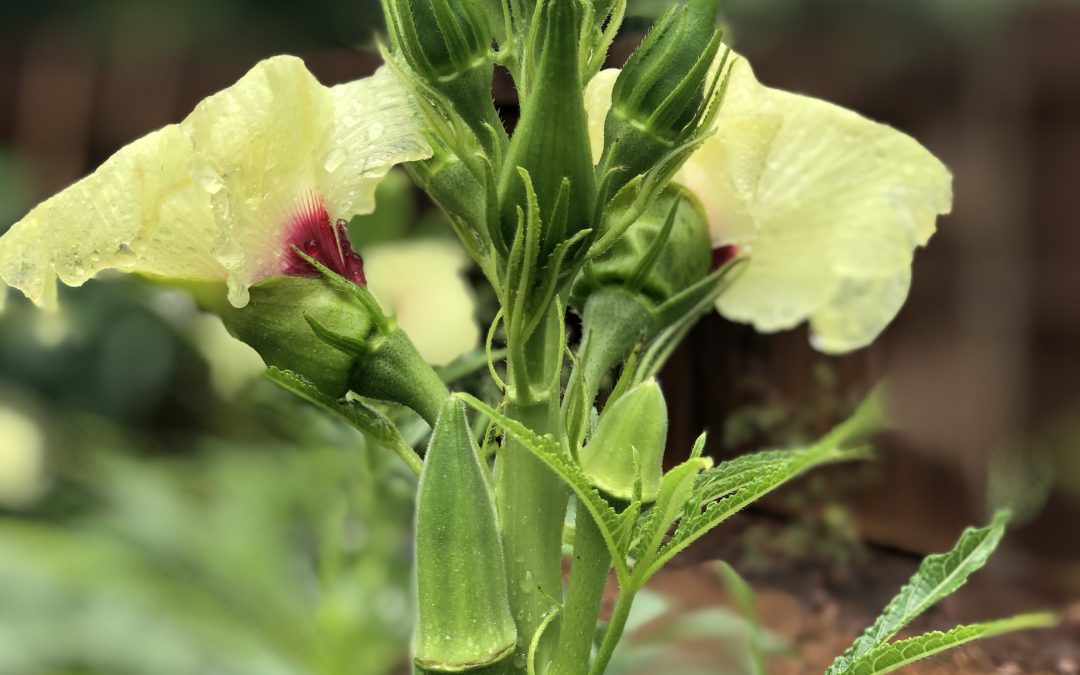
by Daniel J. Leonard | Aug 20, 2019
Though Okra (Abelmoschus esculentus) fruit isn’t much more than a thick green hull, slime and seeds and the plant itself is impossibly irritating to the skin, few plants are as integral to Southern heritage. In my mind, okra is among the best vegetables Panhandle gardeners can grow. Not only is it a gorgeous plant – Okra belongs to the Mallow family which also includes beauties like Hibiscus and Cotton – but it’s exceedingly versatile in the kitchen, excellent fried, grilled, roasted, boiled (though you have to acquire a taste for slimy textures to enjoy this method) and most famously, as a thickening agent in Cajun gumbo. Because of this exalted status in Southern culture, whether you enjoy eating okra or not, it’s almost mandatory here to include the plant in one’s garden. Most gardeners stick with the old standard varieties such as ‘Clemson Spineless’ or ‘Cowhorn’ and there is nothing wrong with them, however, these plants are almost too prolific for most gardens (growing upwards of 6-7’), especially for those of us growing in the close confines of raised beds. In the search for a less rambunctious but still ultra-productive cultivar, this summer I trialed ‘Jambalaya’, an F1 hybrid developed by Sakata Seed in 2012, with impressive results!
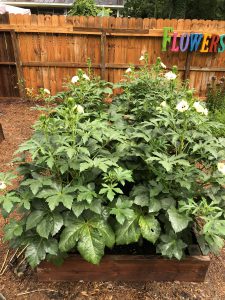
‘Jambalaya’ Okra in the author’s garden.
From my experience growing the cultivar this summer, ‘Jambalaya’ merits consideration in the garden, and is a must for raised bed gardeners, for two primary reasons. First, it was bred to be compact and is considered a dwarf cultivar. This is an awesome attribute, as I typically end the growing season picking okra from a small ladder! Most seed purveyors tout the plant as reaching a maximum height of 3-4’ and while this estimate might be a little conservative, I can attest that ‘Jambalaya’ is greatly reduced in height compared to the standard cultivars. The second advantage of growing this variety is that it begins producing very early relative to its peers and bears heavily. ‘Jambalaya’ fruit begin to ripen in about 50 days, about ten days to two weeks earlier than ‘Clemson Spineless’, a definite advantage if rotating behind a late maturing spring crop like potatoes as I typically do. Though ‘Jambalaya’ is a dwarf plant, in no way are yields reduced. My specimens have produced continuously since late-July and will continue to do so as long as adequate fertility and consistent harvesting are provided.
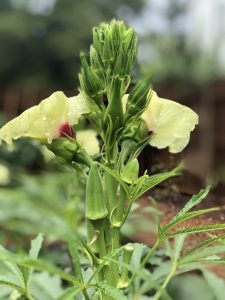
‘Jambalaya’ flower & fruit production.
Like any other okra cultivar, ‘Jambalaya’ has a couple of basic requirements that must be met for plants to thrive. In general, all okra cultivars love Southern summers and patience sowing seed is recommended, allow the soil to warm to at least 70 degrees before planting. Okra also prefers full sun, at least 6 hours per day, any less and yields will be reduced and plants will stretch towards the light. Belonging to the Mallow family, okra requires consistent moisture, particularly when in the flowering and fruiting phase. Finally, it is critical to keep up with your okra harvest as the plants produce! Okra pods grow quickly and should be harvested when they are no more than 3-4” long and still tender, larger pods are tough to the point of being inedible!
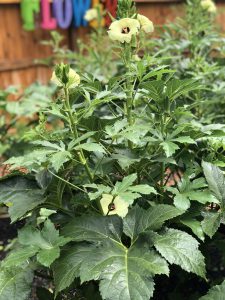
‘Jambalaya’ in the author’s garden.
Whether you’re new to the okra growing game or you’re a seasoned gumbo gardener, I highly encourage you to give ‘Jambalaya’ Okra a look next summer. While ‘Jambalaya’ is available through many seed sources, Johnny’s Selected Seeds sells a conveniently small package perfect for backyard gardeners, though they’ll be happy to provide larger quantities as well. In ‘Jambalaya’ you’ll find a nice compact plant that won’t outgrow your space, provide you a summer long harvest of tender green pods, and will rival the ornamentals in your landscape for the title of prettiest plant on your property! Happy gardening and as always, if you have questions about vegetable gardening or any other horticultural or agronomic topic, please contact your local UF/IFAS County Extension office!
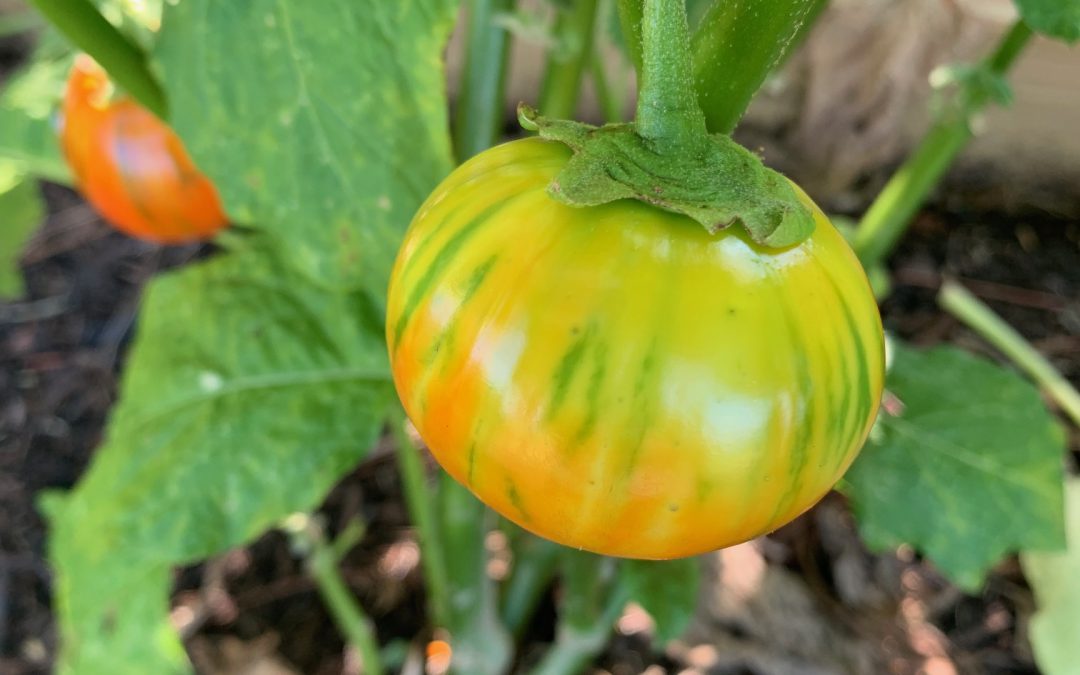
by Mary Salinas | Aug 1, 2019
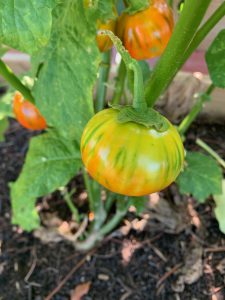
Turkish Orange Eggplant. Photo credit: Mary Salinas, UF/IFAS Extension.
Mid-summer in the Panhandle vegetable garden is prime time to be offering up a great crop of eggplant. This is one of my favorite summertime fruits to grow! (Yes, it is botanically speaking a ‘fruit’ and not a ‘vegetable’.)
Many home gardeners are familiar with the standard ‘Black Beauty’ variety that produces large plump fruit, but there are many other eggplant varieties to try. Take a look at Heirloom Eggplant Varieties in Florida to get some ideas. Gardeners can access dozens of varieties through online seed vendors. Eggplants can be dark purple, purple-striped, pale purple, white, green and even orange. They come in all shapes and sizes and all are delicious to eat, j make sure you learn when to harvest the variety you choose for optimum enjoyment. For example, the Turkish Orange illustrated in the photo should be picked before it turns all orange to avoid any bitterness.
In the panhandle, plant eggplant anytime February through August for harvest late spring through fall. Eggplant is in the nightshade (Solanaceae) family along with tomato, pepper, and potato. Keep that in mind when you are planning your garden for next year to avoid planting members of the same family in the same spot year after year, which encourages recurring disease and pest issues.
Eggplant loves rich soil and benefits from regular fertilization with commercial fertilizers or applications of compost. Eggplant is considered a long season crop and one can expect harvest to begin around 90-110 days after planting seed or 75-90 days if setting out transplants. Eggplant is, in general, more drought tolerant than tomato but it is still good practice keep them consistently moist and avoid letting them completely dry out. Also, while eggplant is self-pollinating, it is an excellent pollinator plant, as many species are attracted to the pretty blooms.
Eggplant is also relatively easy to grow, not generally requiring pruning or staking. Many of the same pests of tomato and pepper will also be attracted to eggplant. Be on the lookout for tomato hornworm and other caterpillar pests. For natural pest control methods, consult Natural Products for Managing Landscape and Garden Pests in Florida
For more information:
Florida Vegetable Gardening Guide
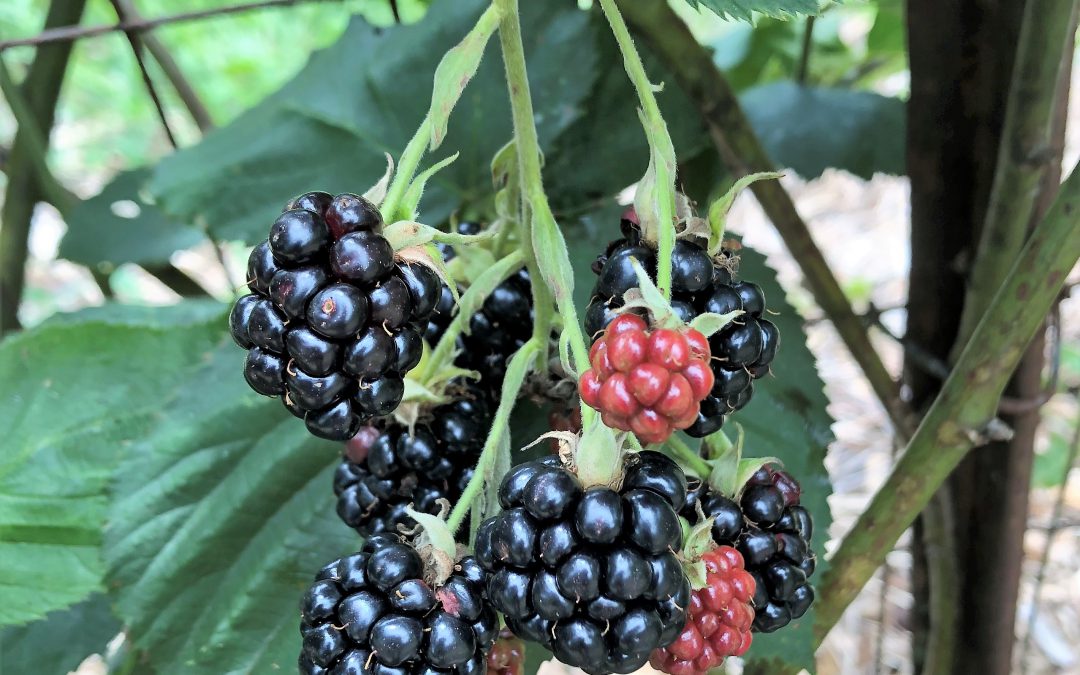
by Molly Jameson | Jun 25, 2019
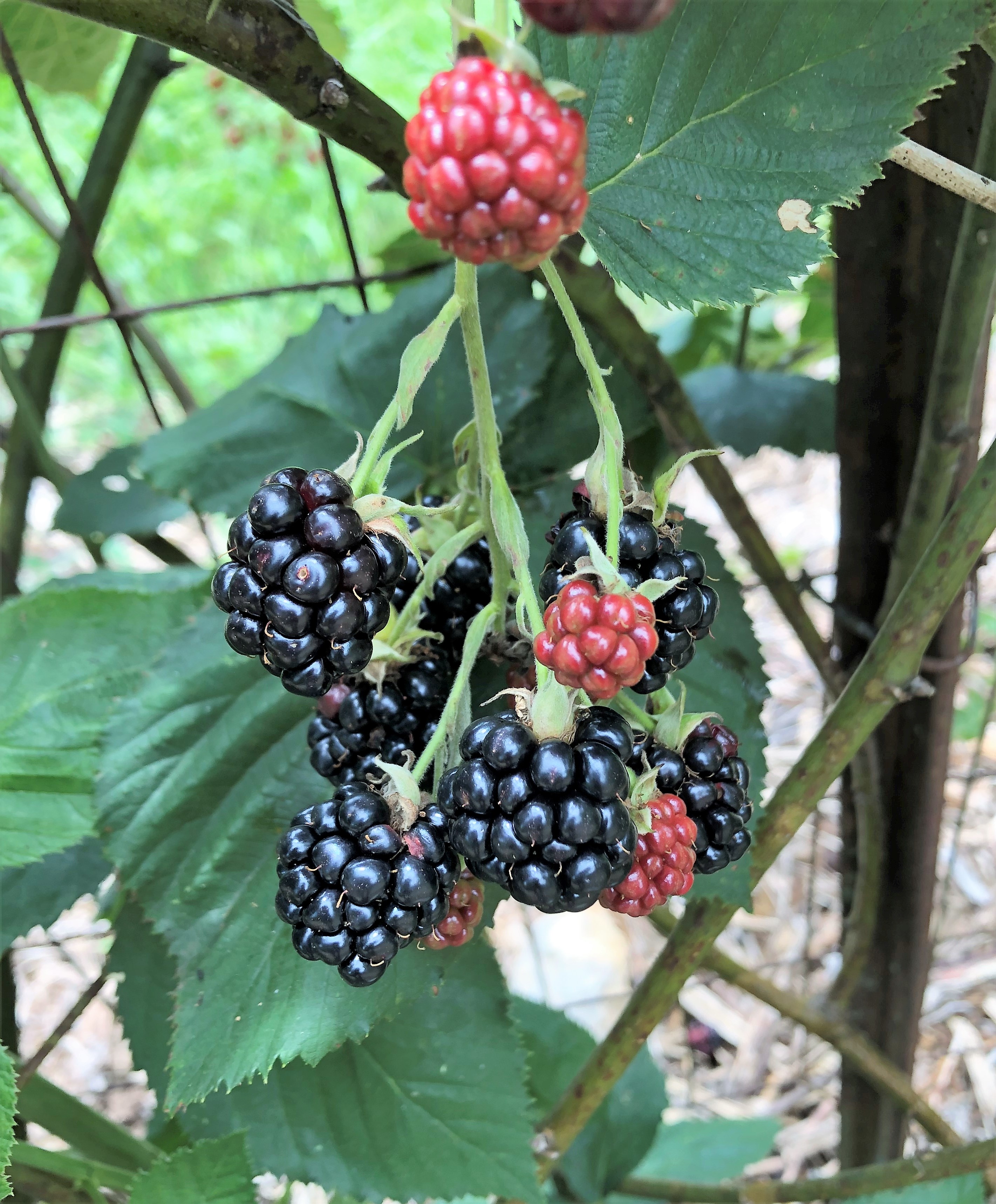
Although blackberries are well adapted to North Florida, many different biotic and abiotic factors can impact fruit production. Photo by Molly Jameson.
Diagnosing Abiotic Blackberry Fruit Disorders
Whether it be wild blackberries you’ve foraged or a prized cultured variety you’ve oh-so-carefully sustained, we are now in prime blackberry season, and there are many sweet, tangy delectable fruits to be eaten.
Blackberry bushes are well adapted to the Florida Panhandle and the plants can be found growing all over – along roadways, in ditches, throughout open fields, and also within forests.
Although wild blackberries and domesticated cultivars thrive in our climate, there is a wide range of factors that could affect blackberry fruiting. When diagnosing plant problems, we tend to blame insects and diseases, but there are many abiotic (non-living) factors that could negatively impact blackberry fruit production. If your blackberry drupelets (the small subdivisions that comprise a blackberry fruit) are compromised, you may be experiencing one or more of the following abiotic blackberry disorders.
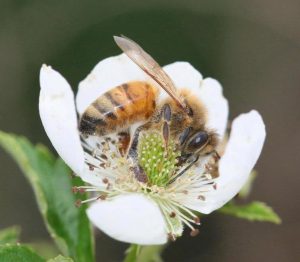
Although blackberries can self-pollinate, insect pollination is critical for forming the best blackberries. Photo by Johnny N. Dell, Bugwood.org.
Poor Pollination. Blackberries, strangely enough, are not true berries botanically. True berries only have one ovary per flower (such as bananas, watermelons, and avocados!). Each blackberry flower contains over 100 female flower parts, called pistils, that contain ovaries. To form a fully sized blackberry with many drupelets, at least 75% of the ovaries need to be pollinated. While blackberries can self-pollinate, pollinator insects, such as bees, are very important to ensure adequate drupelet formation. When weather conditions are overly cloudy and rainy, bees are less active. If this coincides with blackberry flowering, you may end up with some blackberries that are nearly drupe-less.
White Drupe. If you notice patches of white and brown drupelets on your most sun-exposed canes, you might have white drupe disorder. When humidity drops and temperature heats up, solar radiation contacting your berries is more powerful, as there is less moisture in the air to deflect the intense heat. Berries that are not protected by leaf coverage, and those on trellises oriented for maximum sun exposure, are most vulnerable to white drupe damage.
Sunscald. Often associated with white drupe, sunscald is most common when temperatures are extreme. Daytime highs in the Florida Panhandle in June and July regularly reach 90°F, if not higher. At these times, fruit exposed to the sun can be hotter than the air temperature around them, which essentially cooks the fruit. As I suspect you’d prefer to cook your fruit after harvest in preparation for blackberry pie, orient your trellis so it gets shade relief during the hottest part of the day and harvest often.
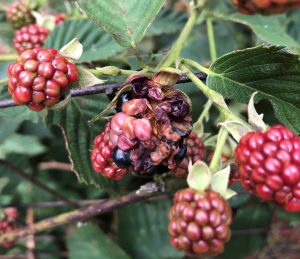
Diagnosing a blackberry issue can be challenging, as there can be more than one culprit impacting the fruit. Photo by Molly Jameson.
Red Cell Regression. One of the not-so-well understood abiotic blackberry disorders is red cell regression, or red drupelet disorder. If you’ve ever harvested blackberry fruit and stored them in the refrigerator for later munching, you may think your eyes are deceiving you when you discover your fruit doesn’t appear as ripe as when you picked it. This regression in color is linked to rapid temperature change, but rest assured, it does not affect the sugar content of the fruit. There are a few things you can do if you think this is affecting your berries, such as harvesting in the morning when the berries are still cool, harvesting when the sky is overcast, or shading your berries pre-harvest. You can also try to cool your berries in stages, perhaps moving from the field, to shade, to A/C, and then to the fridge.
Beyond abiotic stresses, blackberries can also suffer from insect, pest, and disease damage, such as from stink bugs, beetles, mites, birds, anthracnose, leaf rust, crown gall, and beyond. For domesticated blueberry bushes, proper cultivar selection, site selection, planting technique, fertilization, irrigation, propagation, and cane training is important and will allow the plants to grow healthy to defend themselves against any abiotic or biotic nuisance that comes their way.
For more information about growing blackberries, check out the EDIS publication, The Blackberry (https://edis.ifas.ufl.edu/hs104).
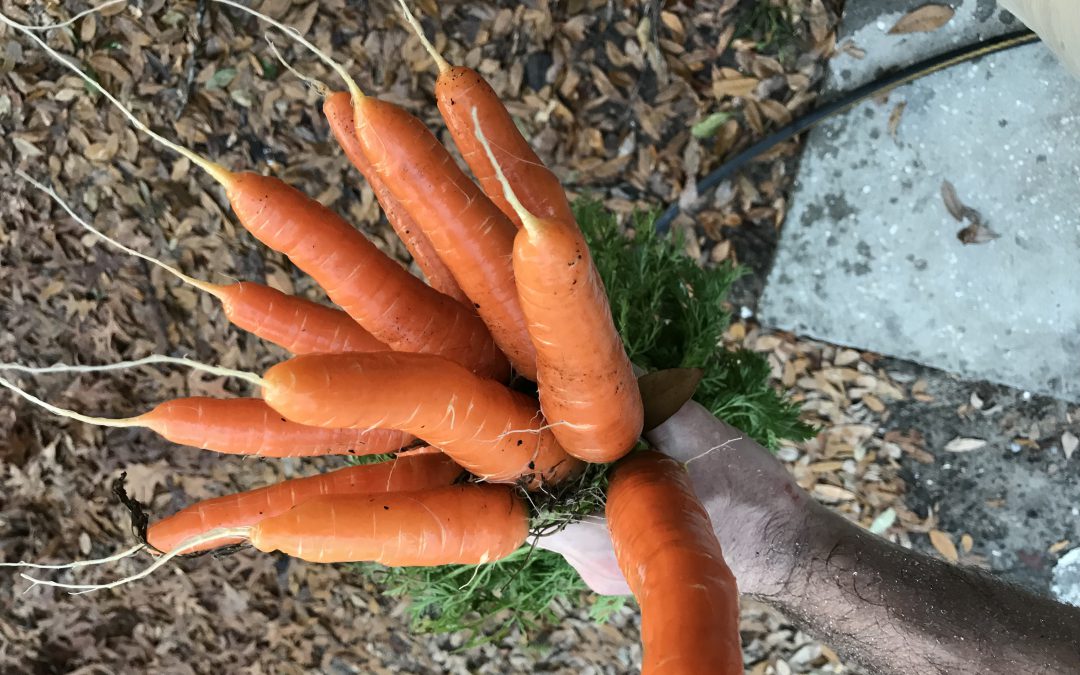
by Daniel J. Leonard | Apr 8, 2019
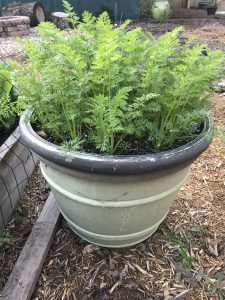
Carrots growing in a large container.
After tending a home vegetable garden for any length of time in the Panhandle, you begin to learn some things. Tomatoes are awfully hard to grow. Raised beds drastically lower the difficulty of gardening in general. You should never plant mint in a permanent veggie garden. Swiss Chard has to be started early because it grows as molasses creeps. Of all of these anecdotal maxims I’ve discovered, the one with the most flavor return on my gardening investment is that carrots should always be a part of your cool season garden. A fresh carrot out of the garden is hard to beat. The difference between a grocery store carrot and one fresh out of your own garden is astonishing and will change your culinary life. Though carrot season in Florida is just ending (my final batch was harvested yesterday), it’s the perfect time to learn about growing carrots here and plan to get some in the ground this fall!
There are a number of reasons to grow and eat carrots. They’re obviously very healthy, though I dispute the whole eat carrots and you’ll have great eyesight thing – apparently I acquired the taste for them too late to help. They go well in more dishes than they don’t. However, the real two reasons you should supplement your grocery store carrot purchases with home grown harvests are that they’re so easy to grow and that there are so many more options than the standard long, thin orange varieties adorning the produce aisle shelves.
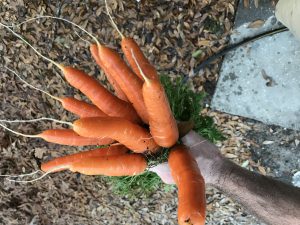
‘Bolero’ Carrots
Though carrots are remarkable easy to grow, they do ask a couple of things of gardeners. They are a cool season vegetable and are generally planted from seed beginning in late August through early September in the Panhandle, though successive plantings can continue through at least February if you want to extend your harvest. Also, like many other root vegetables, carrots don’t transplant well so direct seeding in the garden is a must. But before you even consider seeding, care must be taken to make sure the soil bed you’ll be seeding in has been properly prepared. One of the few ways to fail growing carrots is to not start with a loose soil free from any potential obstructions. If the development of the carrot root is disturbed by anything during the germination and growing process (this includes manure aggregates or other clumpy soil, sticks, rocks or even a hard layer of soil hiding under your loose compost), the end product will be deformed. To prevent this, thoroughly till your raised bed soil to at least 12” and break up any larger soil particles that are left with your hands. If you don’t get your soil bed perfect though, fear not, deformed carrots are definitely edible, they just won’t look like they’re supposed to and are more difficult to clean and process!
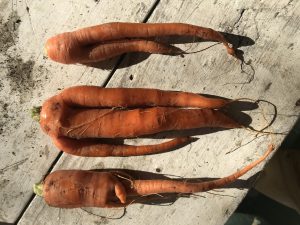
Deformed carrots due to clumpy compost!
Once you’re ready to plant, I’ve found it easier on poor eyes and fumbling fingers like mine to sprinkle the tiny carrot seeds in shallowly furrowed rows 10”-12” apart and thin the seedlings later, rather than trying to individually space seeds the recommended 1”-3” apart. Finally, these colorful little veggies love water and require good fertility. To ensure good expansion of the edible root, maintain consistent moisture and fertilize at planting with a good slow release fertilizer. Additional fertilizer applications may be required later in the growing season as most carrots take around ten weeks to gain maturity.
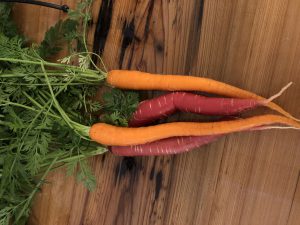
‘Sugarsnax’ (orange) and ‘Malbec’ (red) carrots
In this age of online catalogs, farmer’s markets, and demanding consumers who crave interesting food, the selection of carrot varieties available for gardeners to grow has never been better. Among the hundreds of individual cultivar options are several broad types of carrots you’ll need to choose from. You’re probably familiar with the Imperator types. These are the extra-long, durable carrots most often find in stores. If you have a deep raised bed or other large container, Imperator varieties can be extremely rewarding! I grew the Imperator-type ‘Sugarsnax’ this year and highly recommend it for ease of growing, size and flavor. Next up are the Nantes types. These carrots are medium length and cylindrically shaped. Sometimes called “storage” carrots, these types tend to store well for long periods of time after harvest and retain their flavor well. I’ve tried a few over the last several years and can recommend ‘Bolero’ and ‘Napoli’ with confidence. There is even a carrot type for those of you with shallow raised beds (8” or less) that can’t accommodate the previously listed types! Chantenay type carrots are excellent performers in these situations as they are generally a bit shorter and possess a conical shape with roots wider at the top and tapering to the tip, making a deep soil bed a bit less critical. Finally, there are even some excellent cultivars of carrots in colors other than orange! That’s right, you can grow white, purple, yellow, and even red carrots! I’ve done very well with ‘Purple Haze’ (purple with orange interior), ‘White Satin’ (creamy white color), and ‘Malbec’ (deep, rich red) and highly recommend all three. Keep in mind that the red and purple carrots tend to lose their color when cooked, so the greatest effect is seen when eaten fresh. All of these cultivars can be found at nearly any of the numerous online and catalog seed retainers such as Johnny’s Selected Seeds, Baker Creek Heirloom Seeds, Burpee, and others.
As you can see, carrots are an easy to grow, extremely rewarding vegetable for the home gardener; give some a try in your raised beds next fall! And as always, if you have any questions about growing carrots or any other gardening related question, contact your local UF/IFAS Extension office!






















